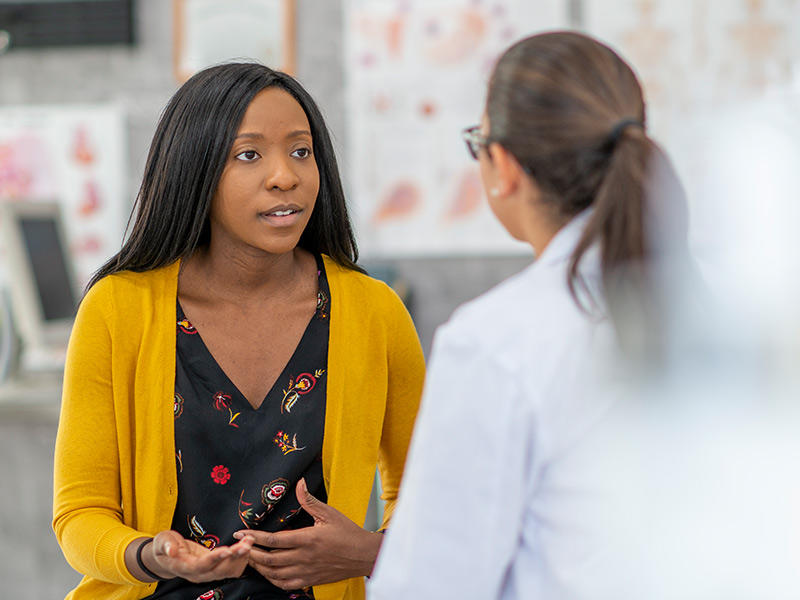How Breast Cancer Risk Assessment Tools Work
, by Sharon Reynolds
In March 2024, the actress Olivia Munn announced that she had been diagnosed with breast cancer. Ms. Munn also highlighted the role a cancer risk assessment tool played in the process that led to her diagnosis. In this Q&A, Ruth Pfeiffer, Ph.D., and Peter Kraft, Ph.D., of NCI’s Division of Cancer Epidemiology and Genetics discuss how these tools are created and how people can use them to understand and manage their risk.
Can cancer risk assessment models predict whether an individual woman will develop breast cancer?
Dr. Pfeiffer: Women want to know: Will I get breast cancer? Unfortunately, these models cannot predict the future with certainty for any one individual. They present population averages.
For example, if a woman’s risk estimate over a predefined time period is 5%, that means that out of 100 women who have the same risk factors as her, such as age and family history of breast cancer, 5 will develop breast cancer over that period. But we can’t identify the exact 5 women out of that 100 who will develop breast cancer.
Dr. Kraft: And it’s important to remember that these estimates of risk do not guarantee a specific outcome. So, you could have a relatively high-risk value on a given tool, but that doesn’t necessarily mean you will get breast cancer. And just because you have a low value doesn’t mean you won’t get breast cancer.
Dr. Pfeiffer: No woman should think, “I don’t need to get screened because my breast cancer risk is low.” On the flip side, there is no need to panic if her risk is high.
There are multiple breast cancer risk models out there. How are they different?
Dr. Pfeiffer: One big difference is the [risk] factors the models consider. In addition, some take into account that a woman might die from causes other than breast cancer. NCI’s risk assessment models for breast cancer, colorectal cancer, and melanoma do this. Other models estimate what we call pure risk: the probability that a woman will get breast cancer if she couldn’t die from anything else. These models produce higher estimates of risk.
All models use slightly different information, but all models use information on factors that have been shown to be associated with breast cancer risk. They consider things like a woman’s family history of cancer, number of childbirths and her age at those births, and whether she has had a benign breast disease. Benign breast diseases are conditions that may show up on a mammogram and lead a woman to have a biopsy, but they are not breast cancer.
These factors do not necessarily cause breast cancer, but, for whatever reason, they predict one’s risk of breast cancer.
What can people do with the information from a risk assessment tool?
Dr. Kraft: It’s really important that they talk with a health care provider about what the risk estimates mean for them. That’s the opportunity to discuss: Am I at high risk? If so, what can I do about it? What are the recommendations for me?
Dr. Pfeiffer: There are also breast cancer risk prediction models out there that include potentially modifiable risk factors, like body mass index, alcohol consumption, and hormone replacement therapy use. So someone could play around with these factors and ask: What would be my risk if I did not drink alcohol? Or if my body mass index was in the normal range? That could help someone make personal decisions about certain lifestyle changes.
Other decisions, like those about screening or taking medications that can reduce your cancer risk, which can come with side effects, need to be made together with a health care provider. But that shouldn’t deter anybody from going online and just seeing what their risk is.
Knowledge is power. And that knowledge could encourage women to reach out to their [health care provider] for help putting such information in context.
What is NCI doing to make risk models more useful or accurate?
Dr. Kraft: The NCI Breast Cancer Risk Assessment Tool and others like it use factors that people know about themselves. They don’t include the risk that you may have from your genetic makeup.
Unfortunately, most studies of the inherited risk of breast cancer have been done in people of European ancestry. These genetic studies have not had large numbers of Black Americans, Latinos, Asian Americans, or Pacific Islanders, for example. Models that incorporate genetic information, such as whether someone has certain gene changes, may not perform as well in these population groups.
At NCI we’ve launched the Confluence Project, which is looking at the genetics of breast cancer across diverse populations.
One of Confluence’s main tasks is to increase the sample size from diverse groups. This can improve model performance for everybody, but especially for people who have been historically excluded from genetic studies.
Then, the Breast Cancer Risk Prediction Project is bringing together the new genetic results from Confluence with some of the existing models.
Dr. Pfeiffer: The more data we have, and the more representative those data are of the populations in which we would use a model, the better that model will perform.
For example, NCI researchers developed a breast cancer risk model for Hispanic women. That model distinguishes between Hispanic women born in the United States and those born in other countries, because the data we have tell us that their risks are different.
Learn more about breast cancer risk.
